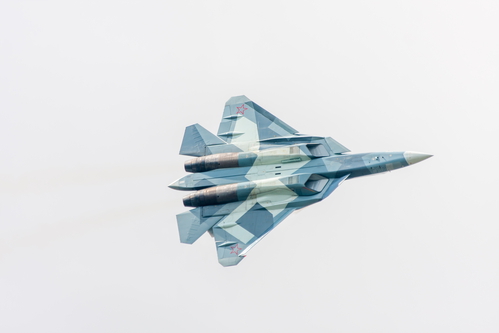
The Russian Su-57 Felon, a fifth-generation combat aircraft, has been conspicuously absent from the conflict in Ukraine, leading to scrutiny over its capabilities and Russia’s strategy.

The Su-57, claimed to be a contender against top-tier U.S. aircraft like the F-35 and F-22, has not engaged in combat, while older Soviet-era aircraft shoulder the burden.

Despite the claims of advanced stealth and warfare capabilities, Russia’s hesitation to deploy the Su-57 in Ukrainian skies suggests a fear of losing these expensive and limited-in-number aircraft.

The decision not to risk these aircraft reflects a broader trend in contemporary warfare, where high-tech weapons systems are being challenged by simpler, cheaper countermeasures.

In theory, a fifth-generation fighter jet is designed to intimidate and overpower an adversary from a considerable distance, utilizing cutting-edge stealth technology to render these aircraft virtually undetectable and impervious to attacks.

However, this ideal scenario does not always hold true.

Therefore, moving forward, major global powers like the United States must anticipate the possibility that their latest weapons systems could become ineffective in a conflict where the enemy has successfully deployed countermeasures to neutralize the capabilities of the most advanced military assets.

The Russian Sukhoi Su-57 Felon and the American Lockheed Martin F-22 Raptor are fifth-generation fighter jets equipped with advanced avionics, stealth features, and supercruise capabilities.

Both aircraft are equipped with highly integrated computer systems that can communicate with other elements in the battlespace, enhancing situational awareness and facilitating command, control, and communications (C3) capabilities.

Initially designed as an air dominance and air superiority fighter, the F-22 can also fulfill roles such as ground attack, electronic warfare, and signals intelligence.

The Russian Su-57 was developed with the capability to engage in aerial combat, as well as conduct ground and maritime strikes.

The F-22 Raptor is considered a more established platform, having entered service in 2005. Originally, the United States Air Force intended to procure 750 F-22s, but the program was scaled back to just 187 aircraft due to high costs, a lack of suitable air-to-air missiles during the Global War on Terror (GWoT), and restrictions on exports.

The Su-57, a newer aircraft encountering challenges in development and production, stands in contrast to the operational track record of the F-22.

Both aircraft exhibit impressive specifications, with the F-22 being perceived as more agile and stealthier, giving it an advantage in air superiority.

Despite their capabilities, neither aircraft has participated in significant air-to-air combat, reflecting their designated roles and the current landscape of aerial warfare.
Relevant articles:
– Russia’s Su-57 Felon Fighter Nightmare Is Just Getting Started, The National Interest
– Stealth Rivals: Comparing the F-22 Raptor and Russia’s Su-57 in Modern Aerial Warfare, nationalinterest.org
